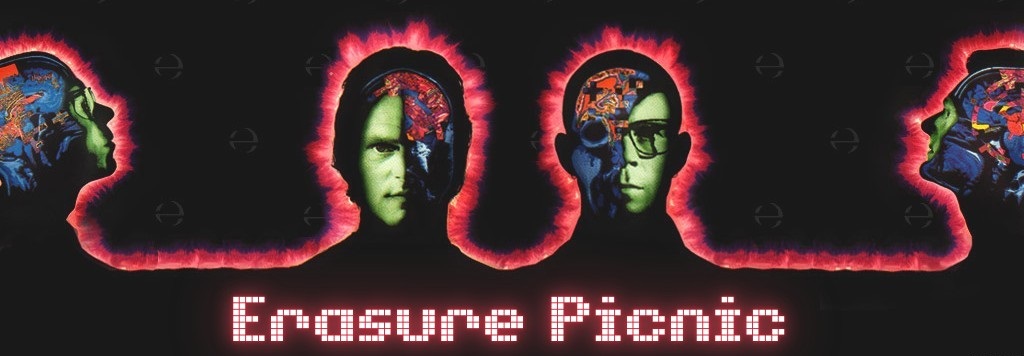The Multisexuality of Erasure, Part 2: Gender on Stage
Slide 1
The Multisexuality of Erasure: Part 2: Gender on Stage
Slide 2
The fluid gender and desire in Erasure’s music can also be found in their live shows.
From the beginning, Andy was playing with gender and shape in his stagewear.
He wore pieces from all over the spectrum: tutus, basques, leotards, tights, bike shorts, bloomers, sailor gear...
Slide 3
He found it fun to dress up, and liked to show off his shape or create new shapes with the clothes he was wearing.
Quote 1: At this point, the conversation inevitably gets back to Andy's, umm, outré dress sense. Andy mentions that he's been thinking of having a nice rubber Roman tunic made up. At the magic mention of rubber, I perk up. A-ha! Do we have another secret rubber fetishist here?
"Not really, but I like clinging things that show your shape off or make up your shape if you haven't got it. I mean, like, it's just having a good time, dressing up like that. It's something to hide behind, and then you get these..."
Source: Record Mirror, November 29, 1986 (Andy speaking).
In the 1987 Smash Hits article “Me and my wardrobe”, he shared his early inspirations: vaudeville, drag, the circus, his gayness, and his favourite performers, most of whom were women. Click or tap the links below to read the full interview!
Smash Hits, "My wardrobe and me" (June 17 1987). Retrieved via Michael Kane.
Slide 4
By the ‘90s, he was moving his stagewear into campier, more androgynous territory.
Quote 1: Indeed. This is a man who announced, "I won't play a heterosexual in our videos," and kept his word by appearing in full saloon-gal drag in Erasure's first such endeavor. On stage, Andy's standard-issue costumes are spangly leotards that focus maximum attention on his legs...and crotch. "Like Madonna," he acknowledges. "You know, pussy power. We've all got it and we can all flaunt it."
Source: Details, November 1991 (Andy speaking).
On the Wild! Tour (1989-1990), he sported a leotard with dark panels on the sides and crotch, to mimic an hourglass shape, draw attention to these areas, and harness feminine power.
Slide 5
On the Phantasmagorical Tour (1992), he went even further. He wore a series of outfits that played with his proportions, turning him into a glamorous, androgynous shapeshifter—the perfect singer for Erasure’s genderless songs. But he wasn’t the only one experimenting...
Fun fact: Andy’s showgirl outfit was inspired by Marilyn Monroe’s costume in the movie Bus Stop!
Source: TCI, February 1993.
Slide 6
For his part, Vince was initially dubious about the idea of appearing onstage in a dress.
Quote 1: Since Vince has come out of himself so much lately, does this mean that maybe he'll be next on stage in a dress? Once again, Vince looks dubious.Vince: "I think I'd be too conscious of meself. You're conscious of yourself enough, anyway."
Source: Record Mirror, November 29, 1986 (Vince speaking).
However, by 1992, with more than a few drag appearances under his belt, he’d changed his tune. During the same tour, he appeared as Mae West, and loved it!
Quote 2: Clarke spends much of each song inside his tank programming his old-fashioned analogue synthesizers to play the following song on their own. Work done, he wanders off for another costume change. His favorite part of the show is his appearance as Mae West, which, he says with enthusiasm, "I do fantastically."
Source: Newsday, October 25, 1992 (Vince speaking).
Slide 7
Both Vince and Andy would continue to play with gender in their stagewear throughout the ‘90s, with Vince also opting for wigs and makeup at times.
Slide 8
Andy also used his singing to present an androgynous persona. During his patter between songs, he would veer between several voices, high and low, inhabiting his “characters” and casting himself in many different roles across genders.
Quote 1: Singer Andy Bell minced, preened and offered chatty little asides in a variety of affected voices that ranged from Placido Domingo to Scarlett O'Hara.
Source: The Philadelphia Enquirer, October 25, 1992.
Quote 2: The people kept yelling at me to tell a joke, but I didn't know any," said the 25-year-old singer. "I was dumbstruck. Now if something like that happens, I'll just go into one of my characters or Vince will get his guitar and we'll do the song acoustically."
Source: The Record, February 15, 1990 (Andy speaking).
Quote 3: His between-songs banter also provided some memorable moments. Bell affected a little girl's voice and repeated some Judy Garland-as-Dorothy lines before launching into a breathy, a cappella version of "Somewhere Over the Rainbow."
Source: The Philadelphia Enquirer, February 15, 1990.
Slide 9
Furthermore, when he covered love songs by female artists, he would never change the lyrics—such as in this performance of the country classic “Stand By Your Man”.
First, Andy introduces himself as “Mabel Mabelline”, inventing and inhabiting a character with bits of his own story, before dropping his hat and flowing into another character, claiming to have “the spirit of Elvis Presley rushing through my veins”.
Slide 10
However, when he sings the song, it’s pretty sincere, with only a bit of camp and cheekiness. This performance captures the unique multisexuality of their live shows.
It’s the principle of “sometimes”. Sometimes Andy and Vince appear as masculine, feminine, or androgynous. Sometimes Andy speaks and sings as a male, female, or androgynous character. Sometimes he’s silly, sometimes sincere. And this is always changing over the course of the show—sometimes within the same number.
It’s possible to read this performance in multiple ways. Andy appears as an masculine, gay-coded figure, but sings the song as written, from a woman’s perspective. As such, is it gay or straight? It’s up to the viewer to decide; it could be either, or both.
Indeed, all of their performances follow the “sometimes” principle, lending themselves to multiple sexual interpretations.
